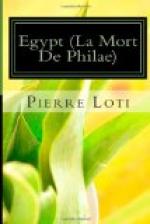It is the month of March, but as gay and splendid as in our June. Around us are fields of corn, of lucerne, and the flowering bean. And the air is full of restless birds, singing deliriously for very joy in the voluptuous business of their nests and coveys. Our way lies over a fertile soil, saturated with vital substances—some paradise for beasts no doubt, for they swarm on every side: flocks of goats with a thousand bleating kids; she-asses with their frisking young; cows and cow-buffaloes feeding their calves; all turned loose among the crops, to browse at their leisure, as if there were here a superabundance of the riches of the soil.
What country is this that shows no sign of human habitation, that knows no village, nor any distant spire? The crops are like ours at home—wheat, lucerne, and the flowering bean that perfumes the air with its white blossoms. But there is an excess of light in the sky and, in the distance, an extraordinary clearness. And then these fertile plains, that might be those of some “Promised Land,” seem to be bounded far away, on left and right, by two parallel stone walls, two chains of rose-coloured mountains, whose aspect is obviously desertlike. Besides, amongst the numerous animals that are familiar, there are camels, feeding their strange nurslings that look like four-legged ostriches. And finally some peasants appear beyond in the cornfields; they are veiled in long black draperies. It is the East then, an African land, or some oasis of Arabia?
The sun at this moment is hidden from us by a band of clouds, that stretches, right above our head, from one end of the sky to the other, like a long skein of white wool. It is alone in the blue void, and seems to make more peaceful, and even a little mysterious, the wonderful light of the fields we traverse—these fields intoxicated with life and vibrant with the music of birds; while, by contrast, the distant landscape, unshaded by clouds, is resplendent with a more incisive clearness and the desert beyond seems deluged with rays.
The pathway that we have been following, ill defined as it is in the grassy fields, leads us at length under a large ruinous portico—a relic of goodness knows what olden days—which still rises here, quite isolated, altogether strange and unexpected, in the midst of the green expanse of pasture and tillage. We had seen it from a great distance, so pure and clear is the air; and in approaching it we perceive that it is colossal, and in relief on its lintel is designed a globe with two long wings outspread symmetrically.
It behoves us now to make obeisance with almost religious reverence, for this winged disc is a symbol which gives at length an indication of the place immediate and absolute. It is Egypt, the country—Egypt, our ancient mother. And there before us must once have stood a temple reverenced of the people, or some great vanished town; its fragments of columns and sculptured capitals are strewn about in the fields of lucerne. How inexplicable it seems that this land of ancient splendours, which never ceased indeed to be nutritive and prodigiously fertile, should have returned, for some hundreds of years now, to the humble pastoral life of the peasants.




